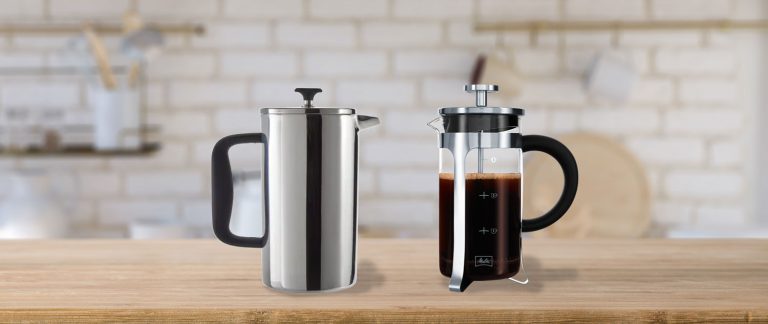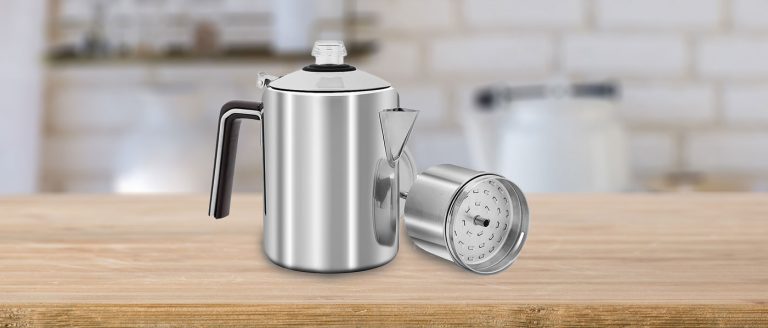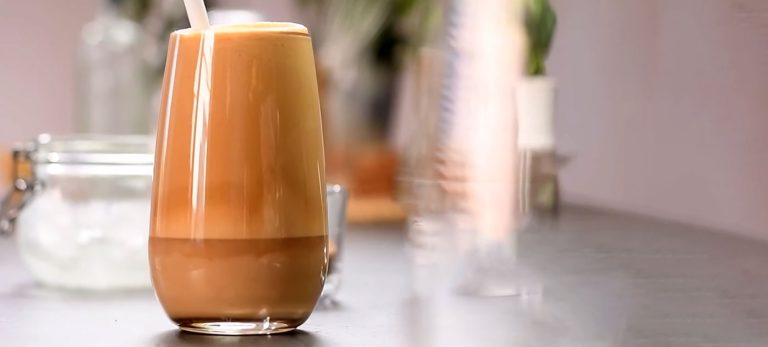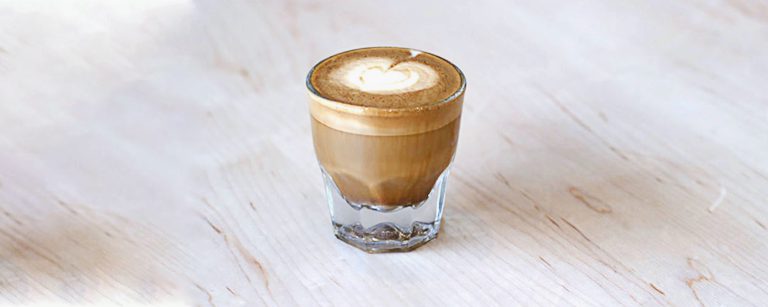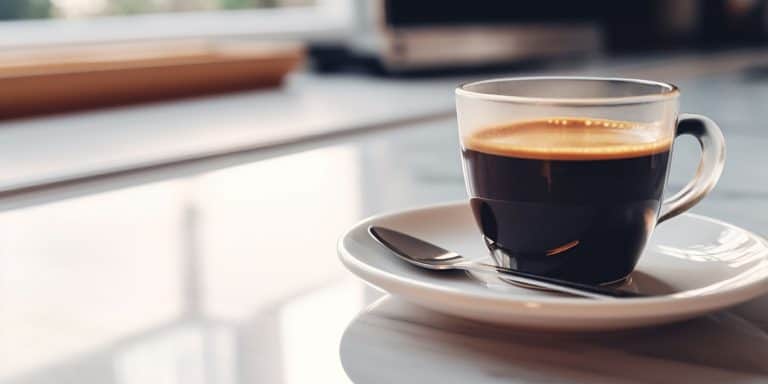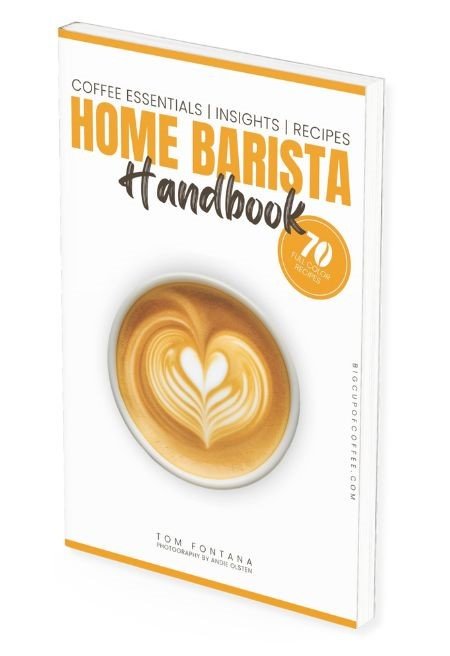How to Make French Press Coffee – 2 BEST Methods
Without a doubt, the French press is one of the most popular ways to make full-flavored coffee. However, people frequently ask me why their French press coffee does not taste that great.
So I made this handy cafetière guide. If you’re a beginner to this brewing method, then you’ll want to read this. In this article, I’ll discuss what the French press is and how you can use it correctly for a perfect cup, every single time.
What is a French Press?
A French press, also known as a cafetière or coffee plunger, is a cylindrical glass or stainless steel container that uses immersion brewing to make coffee. The coffee grounds are fully submerged in brewing water for an extended period of time before being filtered out through a metal mesh screen attached to the plunger.
The origin of the French press can be traced back to the mid-19th century when it was first invented by two Frenchmen named Jacques-Victor Delforge and Henri-Otto Mayer. Over time, different variations of the French press have emerged with varying sizes and materials. Each type has its own unique qualities and preferences depending on your personal taste.

What I love about the French press is its end result – a full-bodied cup of coffee with robust flavors and notes of chocolate, nuts, or caramel depending on the beans used. Additionally, it’s portable, affordable, simple to use, and easy to clean. Seeing the rich coffee swirl as I press down the plunger is always a satisfying sight. Not to mention that it is an eco-friendly way to brew coffee.
Choosing Your French Press
Now that you know what a French press is and why it’s so popular, let’s talk about how to choose the right one for your needs. Here are the factors to consider when you’re buying a French press:
- Material: Glass presses allow you to see the coffee as it brews, while ceramic holds heat well but can be fragile. Stainless steel versions are durable and retain heat better than glass or ceramic models. The choice depends on personal preference really, but I prefer the see-through nature of the glass version.
- Size: Consider how much coffee you typically drink in one sitting, whether it’s just one cup or multiple cups at once. French presses range from small 1-cup sizes to large 12-cup sizes, as described in this article. You can oversize if you like, since you are free to make smaller batches than the max capacity of the model you choose.
- Additional features: You might also want to check out some additional French press features such as insulation (to keep your coffee hotter for longer), an ergonomic handle (for easy pouring), and removable parts for easier cleaning.
When choosing your French press, think about these factors carefully to ensure that you make the best choice for your coffee-drinking needs.
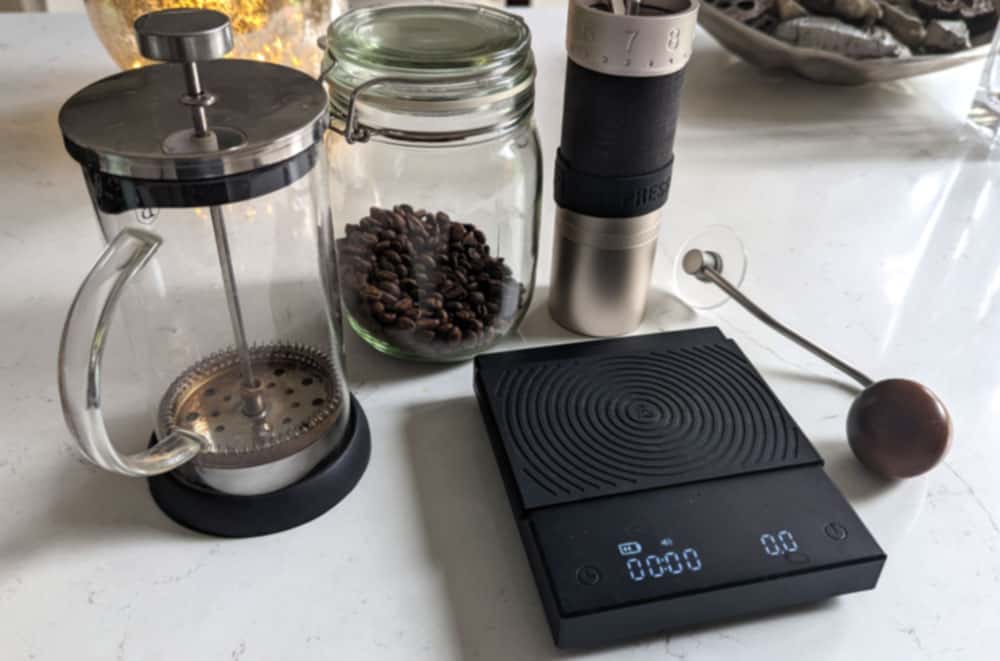
Choosing Your Coffee and Grind Size
Now it’s time to select the right coffee beans and grind size which will directly impact the taste of your coffee.
When choosing which type of coffee bean to use in a French press, medium to dark roasted beans are recommended as they have robust flavors that can stand up to the immersion brewing process.
If you decide to use a lighter roast, I’ve found that it’s a good idea to add 1 minute in total steeping time on top of what I’ll show you in the recipe below. Why? Because light roasts extract a bit slower, and you’ll want to give it time to extract everything your coffee has to give.
You might want to avoid oily beans or “espresso” blends. In my experience, these can clog the mesh filter and result in sediment-filled cups.
As for the grind size, a coarse grind works best for the French press. The resulting grounds should look like coarse bread crumbs or sea salt crystals. Medium grinds are still OK, but finer grinds will run the risk of over-extraction or creating too much sediment since the small particles will flow through the metal mesh filter.
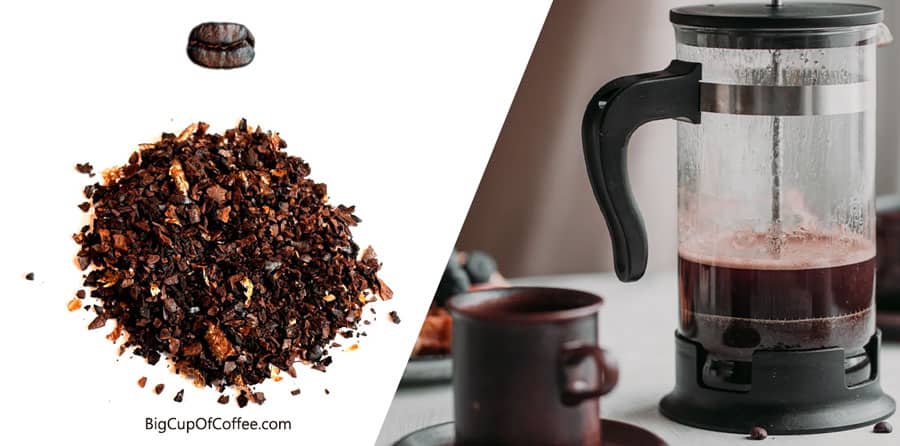
On that note, also avoid store-bought pre-ground coffee as they are often too fine for this brewing method.
What is the best coffee-to-water ratio for French press?
The golden cup ratio of 1:16.66 works great for the French press as well, meaning you use 1 gram of coffee with 16.66 grams of water.
It’s ok to cheat a bit and use 1:16 to 1:17. Nobody will know 🙂
French Press Coffee Yield
The yield of French press coffee is on the low end of the brewer spectrum, since you are not forcing the water out of the carafe (as doesn’t an Aeropress, or an espresso machine.
For example, I just made French press coffee us the 4+5 minute recipe (as described in the next part of the article), here are my results:
- 350 ml brewing water
- 21 g coffee
- 278g coffee yield
The grinds retain a lot of water.
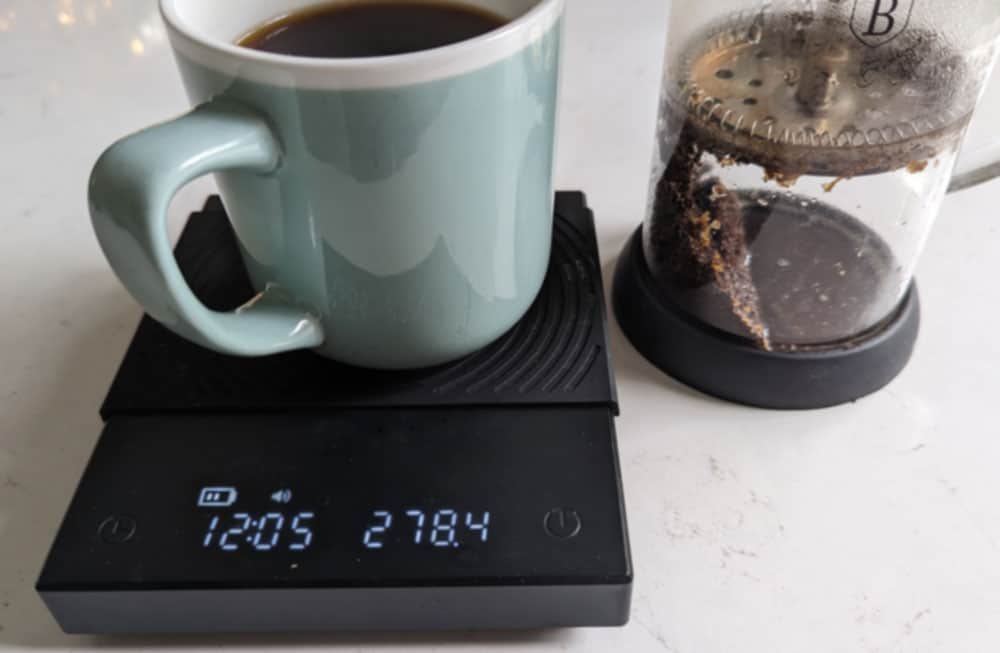
Easy + Upgraded French Press Coffee Recipe
The first, and most basic French press brewing method we’ll talk about is one that’s used by many baristas, and results in a perfectly good cup. There is just 1 problem with it, fines can seep through your plunger mesh.
The upgraded method adds a step, plus 5 extra steeping minutes to the brewing time as based on James Hoffman’s recipe.
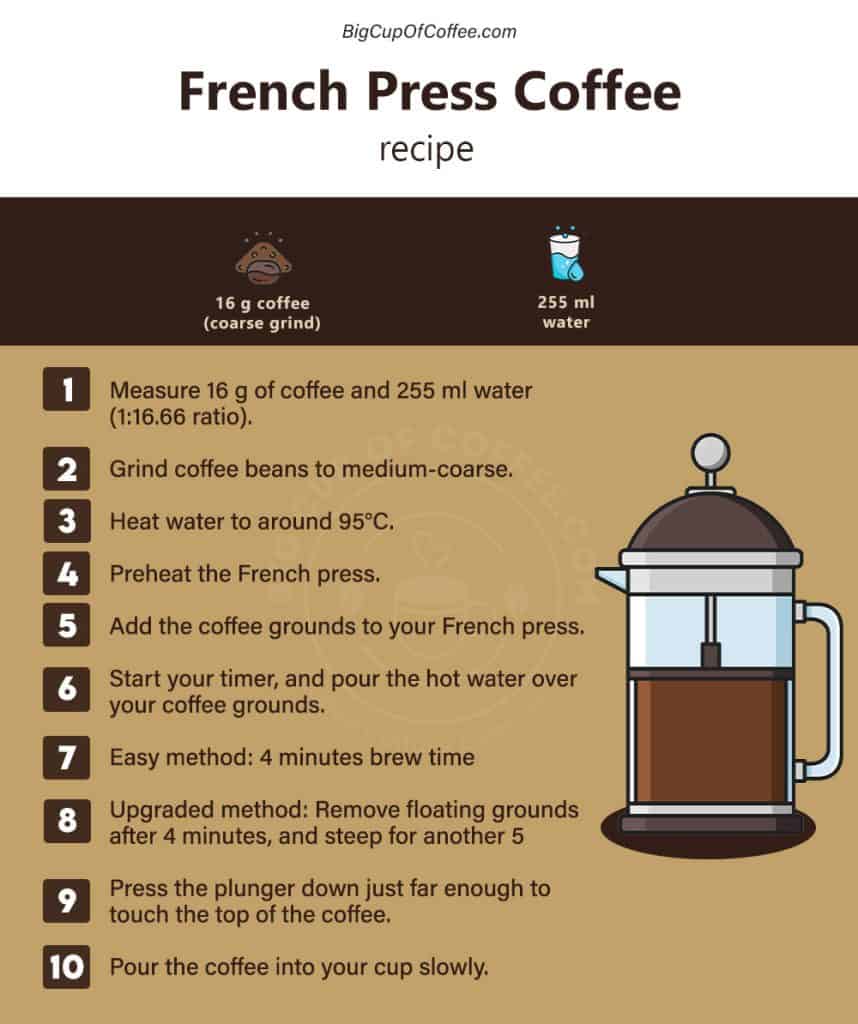
Here are the steps for the easy French press coffee brewing method:
1. Measure the coffee and water ratio.
The recommended ratio of coffee and water for brewing with a French press is 1:16 (one-part coffee grounds to sixteen parts water). For example, if you’re making one cup (8 ounces) of coffee, use 16 grams of coffee grounds and 255 milliliters of hot water.
2. Grind coffee beans.
Grind your whole coffee beans on a coarse setting just before brewing; ensuring enough quantity according to the previously calculated ratio while also accounting for spillage due to static or grinder retention.
3. Heat water to around 95°C
You’re aiming for brewing water just off of boiling. The easiest way to achieve this temperature is to boil the water, remove from the heat and let it rest for 30-60 seconds before pouring it over the grounds.
4. Preheat the French press.
Rinse out the glass carafe with hot water beforehand so that it maintains its heat when you add the coffee to brew later on, and doesn’t cause thermal shock to the carafe.
Make sure to dump the preheating water before moving on.
5. Add the coffee grounds to your French press.
Add the measured amount of coarsely ground coffee into the preheated empty carafe.
6. Start your timer, and pour the hot water over your coffee grounds.
Pour your recently boiled water slowly over the bed of grinds breaking any clumps and stirring gently making sure all are evenly soaked.
Some like to just pour 1/4 of the water, let the coffee bloom and degass, and pour the rest after 30 seconds. I don’t find that it makes much of a difference, so I don’t bother.
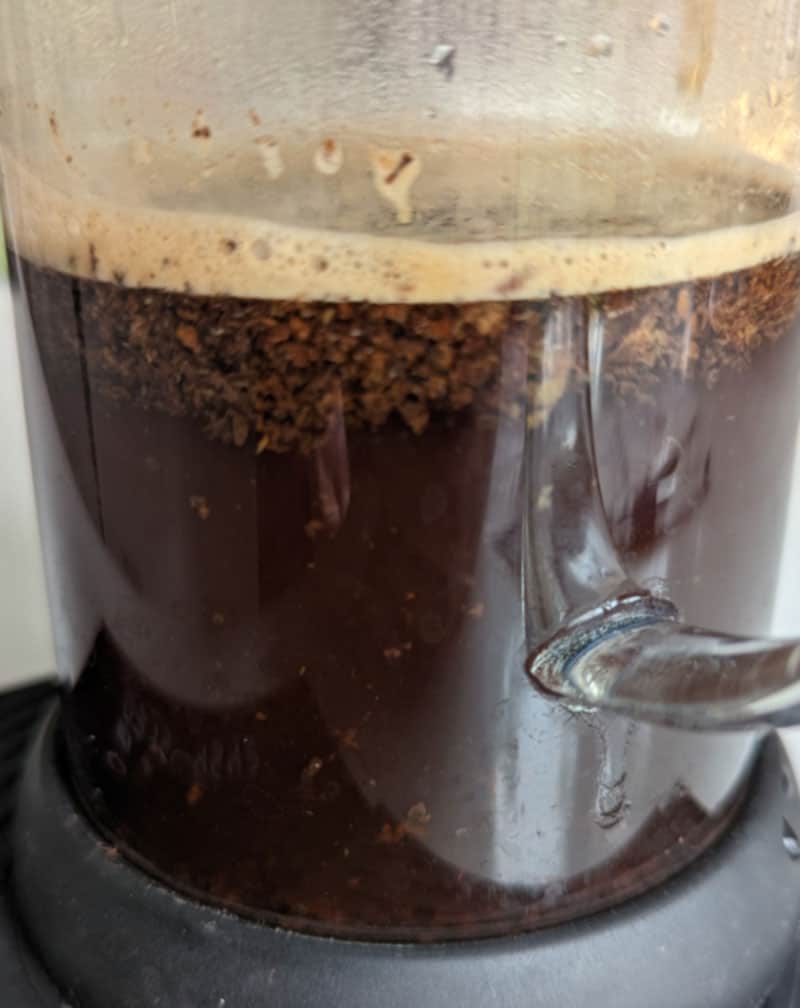
And the next step is where things can go from easy, to upgraded.
7.a. Easy method: 4 minutes brew time
With the classic French press coffee method, you let the grounds steep for 4 minutes, and move on to plunging.
7.b. Upgraded method: Remove floating grounds after 4 minutes, and steep for another 5
This upgraded method does away with those pesky particles that tended to make French press coffee murky. Here is the process you follow:
- After 4 minutes of steeping, mix the top of the brew gently to let it degas.
- Use 2 spoons to remove the coffee froth and coffee grinds that are floating on the surface.
- Put the plunger top back on and let it steep for another 5 minutes.
As you wait, the remaining floating bits settle down to the bottom, resulting in a cleaner cup in the end.
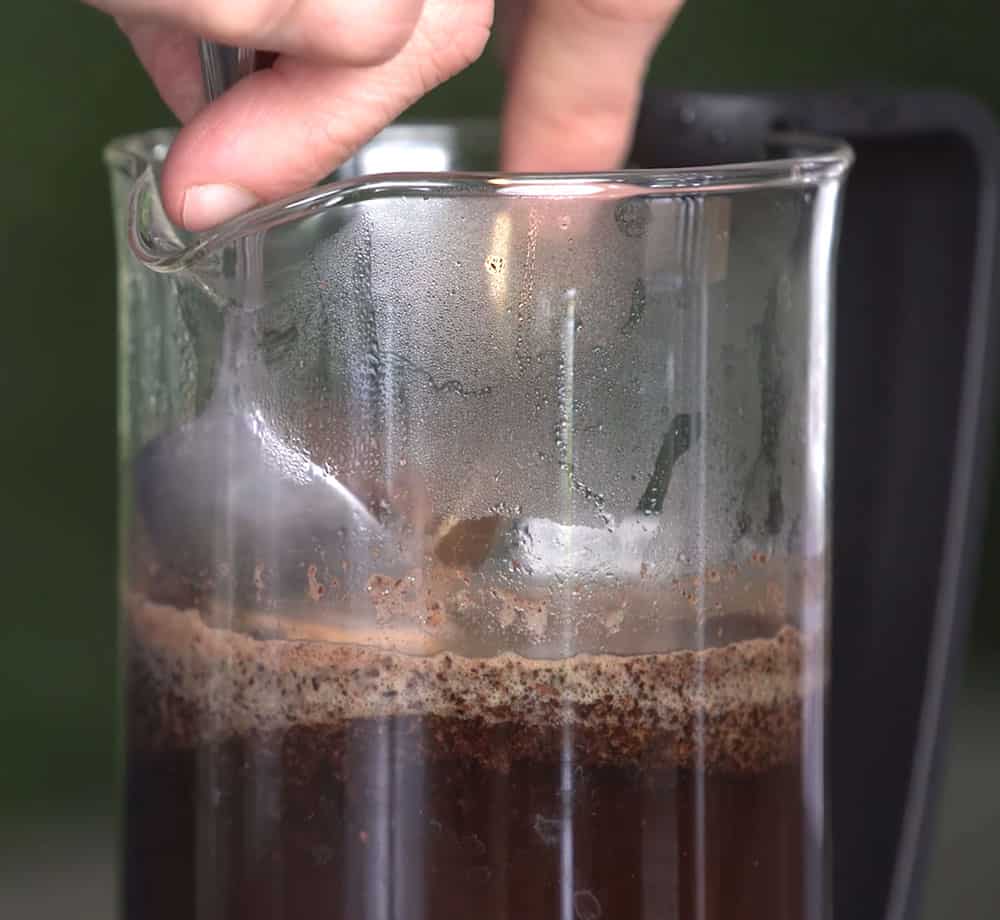
8. Press the plunger down just far enough to touch the top of the coffee.
Now it’s time to press down on the plunger, but unlike what you are probably used to, you will not push down all the way.
Why? Because that stirs up the coffee grinds that have settled at the bottom.
Instead, do this:
- Push the plunger down just far enough, as to touch the top of the brewed coffee.
- Slowly pour out the coffee into your serving cups.
This is the secret to a great tasting cup of French press coffee with no sediments.
By following these simple steps, you’ll be able to make delicious French press coffee every time – just adjust proportions based on personal preferences and keep experimenting until you find the perfect brew for you!
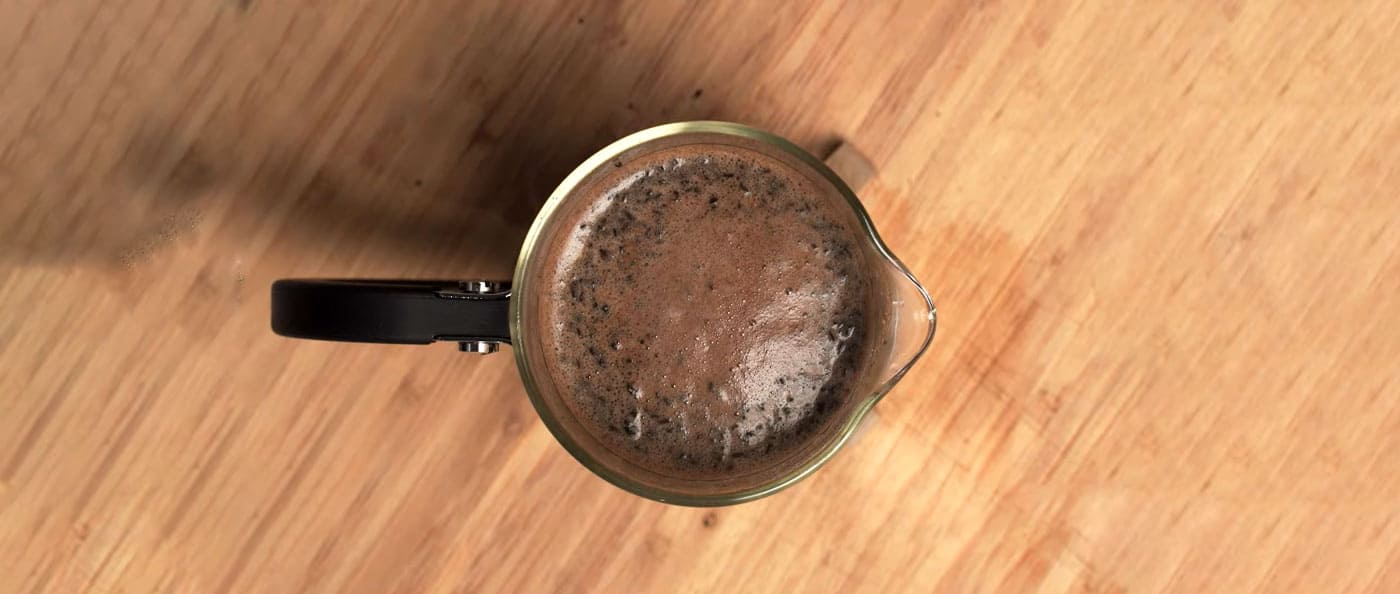
How to Make French Press Coffee
Ingredients
- 16 g coffee
- 255 ml boiling water
Instructions
- Measure 16 g of coffee and 255 ml water (1:16.66 ratio).
- Grind coffee beans.
- Heat water to around 95°C
- Preheat the French press.
- Add the coffee grounds to your French press.
- Start your timer, and pour the hot water over your coffee grounds.
- Easy method: 4 minutes brew time
- Upgraded method: Remove floating grounds after 4 minutes, and steep for another 5
- Press the plunger down just far enough to touch the top of the coffee.
Video
Notes
Troubleshooting Common French Press Coffee Problems
Despite your best efforts, sometimes things can go wrong when making French press coffee. Here are some common problems and their solutions:
What to do if your French press coffee is too weak or too strong?
If the coffee is too weak, increase the coffee grounds or reduce the water volume, and vice versa if it’s too strong. Try adjusting the ratio until you find a taste that’s right for you!
What to do if your French press coffee is too bitter or too acidic?
Over-extraction could lead to bitterness in taste. This can occur for a number of different reasons:
- Steeping for longer than the appropriate time
- Using finer grind sizes
- The temperature is on the higher side
Meanwhile, the high acidity may be caused by under-brewed beans, which did not get enough contact time during immersion brewing. Altering these factors might help balance flavors more evenly.
There’s excessive sediment in your French press coffee.
Using a coarser grind, pouring slowly, and not shaking the carafe before plunging will help minimize sediments settling at the bottom of your cup. Better models also have multiple microfilters to avoid this issue.
Problems with your plunger.
If you’re having trouble trying to push the plunger down, there’s a good chance it might be clogged. To avoid this, be sure to clean all removable parts thoroughly and regularly after each use.
Frequently Asked Questions (FAQs)
Here are some frequently asked questions about French press coffee:
Using pre-ground coffee bought from grocery stores may not be recommended as it is usually finely ground and could result in over-extraction or sedimentation. Therefore, grinding your own beans fresh with a coarser texture is highly suggested.
Using pre-ground coffee bought from grocery stores may not be recommended as it is usually finely ground and could result in over-extraction or sedimentation. Therefore, grinding your own beans fresh with a coarser texture is highly suggested.
Disassemble all removable parts and scrub thoroughly with hot water mixed with mild soap periodically. Avoid abrasive materials that might scratch surfaces causing damage.
Apart from brewing delicious cups of coffee, French presses can also be used for making tea and u003ca href=u0022https://bigcupofcoffee.com/froth-milk-at-home-without-expensive-machinery/u0022 data-type=u0022postu0022 data-id=u00227619u0022u003efrothing milku003c/au003e. Infusing herbs, spices, or oils and extracting their flavors work well too.
In Summary…
Overall, French press coffee is a fantastic way to brew full-bodied and flavorful cups easily. By selecting the right beans and grind size, and following the correct steps, you can make delicious cafe-quality coffee at home with minimal effort.
So next time you’re craving a rich cup of joe, why not use a French press? With these tips and tricks under your belt, success is practically guaranteed.

